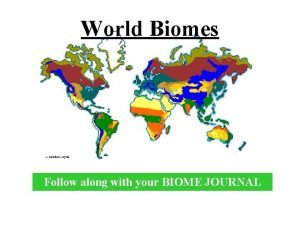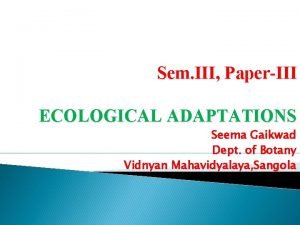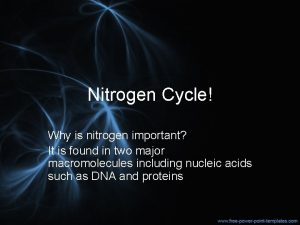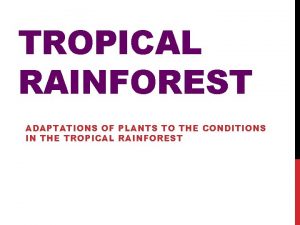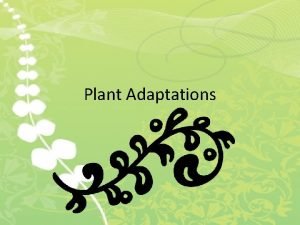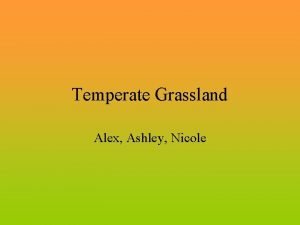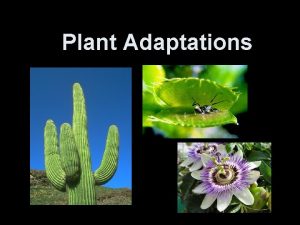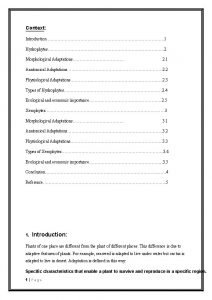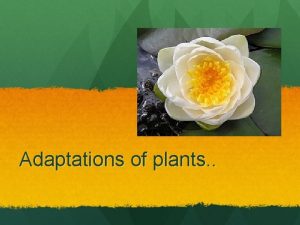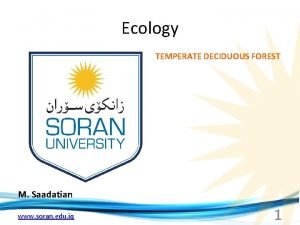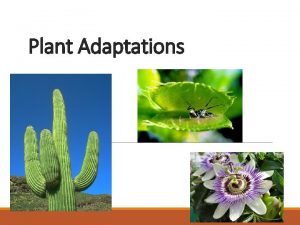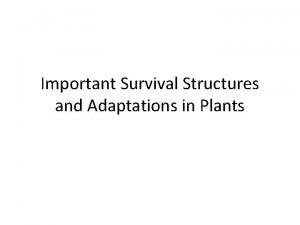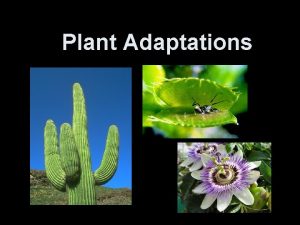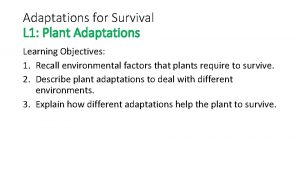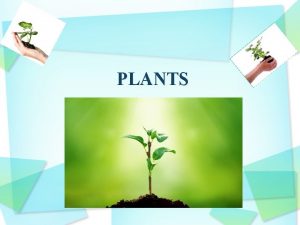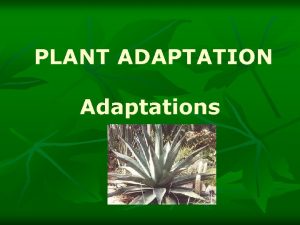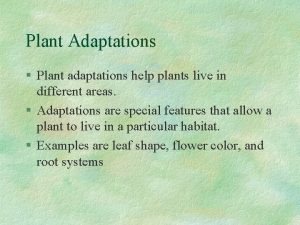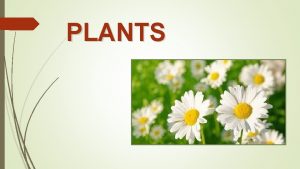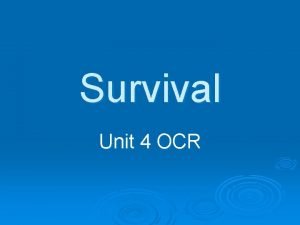Important Survival Structures and Adaptations in Plants Make



















- Slides: 19

Important Survival Structures and Adaptations in Plants

Make a 4 column chart with the following headings • • Nutrition Respiration Reproduction Response to Environment Write down important structures and functions that relate to these 4 concepts as we review the Power Point

Vascular Tissue- Nutrition • Vascular Tissue move fluids through the plant body – 1. Xylem– carries water from the root to the other parts of the plant – 2. Phloem – transports nutrients and carbohydrates made by photosynthesis

Vascular Tissue Chart-Nutrition

Leaves-Nutrition • Designed for absorbing light and carrying out photosynthesis • Two types of leaves: – 1. Simple (one leaf) – 2. Compound (many leaflets)

Leaf Functions-Nutrition • Carries out photosynthesis • Transpiration- evaporation of water through leaves • Gas Exchange – Stomata remains open enough just to allow photosynthesis to take place

Layers of Leaf- Nutrition&Respiration – Mesophyll spongy layer is composed of many chloroplasts – Palisade mesophyll – absorb the light – Spongy mesophyll – air spaces that connect the stomata with outside – Stomata – pore-like openings on the underside of a leaf to absorb carbon dioxide

Stomata On Surface of Leaf. Respiration Swollen Small stoma opening little gas exchange Guard Cells Large stoma opening ample gas exchange Flaccid (weak) guard cells

How the stomata helps to maintain homeostasis? • The stomata allows for the plant to REGULATE the exchange of gases MAINTAIN HOMEOSTASIS – Dependent on the availability of water • When water is plentiful plant can accept more water guard cells swell stomata opens gas exchange can occur readily • When water is NOT plentiful OR wants to conserve the water it has plant can n

Cones in Conifer Plants- Reproduction • Cones and pollen are used as the reproductive structures found in gymnosperms • Exhibit alternation of generations sporophyte and gametophyte phases. • http: //bcs. whfreeman. com/thelifewire/conte nt/chp 30/30020. html

Reproduction in Angiosperms. Reproduction • Also exhibit sporophyte and gametophyte generations • http: //www. sumanasinc. com/webcontent/ani mations/content/angiosperm. html

Flower Parts-Reproduction • Flowers are the reproductive structure in angiosperms. Stamen-> men=male • Male: anther+filament • Contains pollen • Pistil (carpel)-> female – Stigma, style, ovary – Ovary holds the ovules.

Seeds-Reproduction • Seeds in plants play an important role in – Protection of the plant embryo – Prevention of drying out of moisture within the seed – Provides nutrients as it develops

Monocot vs Dicot Seeds

Summary Tutorial • http: //wps. prenhall. com/wps/media/objects/ 838/858365/ch 03 anim/3_1_6_1 a. swf

How Do Plants Respond to the Environment? • 1 -Tropism= response by a plant to an external stimulus – Phototropism response to light – Gravitropism response to gravity – Hydrotropism response to water – Thigmotropism response to touch (surfaces like vines wrapping around) • 2 -Hormones= auxins – cytokinins, gibberlins, ethylene

Plant Auxins- Response to Environment • Auxins substances that regulate cell growth at the tip of plant by stimulating cell elongation. – Cytokinins Stimulate cell division, and cause dormant seeds to sprout. – Gibberillins dramatic increase in size (stems and fruits) – Ethylene Stimulate fruits to ripen

Other Environmental Adaptations. Response to Environment • Aquatic Plants Tissues with large air filled spaces for oxygen diffusion • Epiphytes-Grow directly on other plants to obtain their nutrients Ex. Spanish Moss • Desert Plants (Xerophytes)-Extensive roots, reduced leaves, & thick stems stores water. • Nutrition Specialists-Live in areas with low concentrations of nutrients in the soil. – Ex. Carnivorous plants (Venus Fly Trap) – Parasites (Mistletoe)

 State of survival survival of the fittest tweak
State of survival survival of the fittest tweak State of survival survival of the fittest stages
State of survival survival of the fittest stages Katelyn
Katelyn Mensaje subliminal camel
Mensaje subliminal camel Plant adaptations temperate deciduous forest
Plant adaptations temperate deciduous forest Ecological adaptation of hydrilla
Ecological adaptation of hydrilla Homologous
Homologous Characteristics of flowering and non flowering plants
Characteristics of flowering and non flowering plants Macromolecules with nitrogen
Macromolecules with nitrogen Tropical rainforest adaptations
Tropical rainforest adaptations Adaptations of lotus plant
Adaptations of lotus plant Plants in tropical rainforest adaptations
Plants in tropical rainforest adaptations Chaparral precipitation
Chaparral precipitation Temperate grassland plant adaptations
Temperate grassland plant adaptations Plants structural adaptations
Plants structural adaptations Morphological features of hydrophytes
Morphological features of hydrophytes Tundra animal adaptations
Tundra animal adaptations Mbgnet bioplants
Mbgnet bioplants Adaptations for temperate deciduous forest
Adaptations for temperate deciduous forest Structural plants
Structural plants




